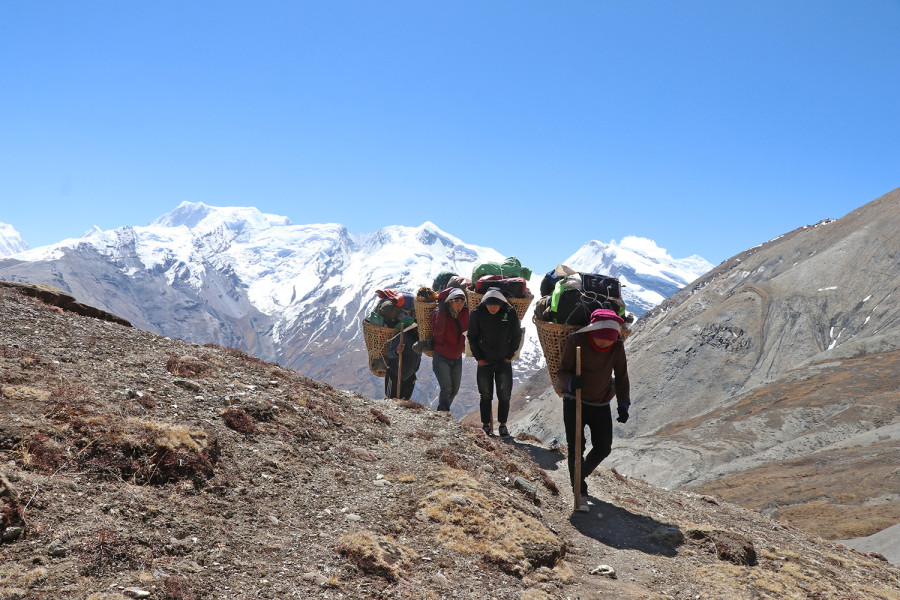Money
Nepal’s economy to grow by 4.61 percent
Economic indicators signal recovery, but low savings, setbacks in tourism, and slow spending still weigh on growth.
Sangam Prasain
Nepal’s economy is projected to grow by 4.61 percent, reaching Rs6.17 trillion in the current fiscal year, according to the annual national accounts released by the National Statistics Office on Wednesday. This growth reflects a recovery from last year, when many economic indicators were negative.
The growth projection is based on actual data for the first nine months of the fiscal year and estimates for the final quarter up to mid-July. However, this projected growth falls short of the government’s initial target of 6 percent.
Last fiscal year, Nepal's economy grew by 3.67 percent. “This year’s 4.61 percent growth indicates that the economy is on a path to recovery,” said Madhusudan Burlakoti, secretary at the National Statistics Office.
Per capita gross national income (GNI)—which measures the total income earned by a country’s residents—is expected to rise to $1,517 this fiscal year, up from $1,467 the previous year. GNI encompasses income from domestic production (GDP) and net income from abroad, providing a comprehensive view of a nation’s economic well-being.
Similarly, per capita GDP—representing the total market value of goods and services produced within the country—is estimated to reach $1,496, up from $1,443 last fiscal year. This figure represents the average income per person and the overall production capacity.
Final consumption expenditure, or the total spending by Nepalis on goods and services, is expected to reach Rs 5.77 trillion, accounting for 93.45 percent of the GDP.
This suggests that savings remain low, with the average person putting aside only 6.55 percent of their income.
Officials expressed concern over this low savings rate.
Worker remittances are projected to account for 25.89 percent of GDP this fiscal year, underscoring the continued reliance on income from Nepalis working abroad. Meanwhile, gross national savings are expected to improve slightly to 36.24 percent, up from 35.39 percent last fiscal year.
The agricultural sector, which contributes 25.16 percent to the GDP, is expected to grow by 3.28 percent. The non-agricultural sector is projected to grow by 4.28 percent.
Among economic sub-sectors, electricity and gas are expected to lead growth at 13.82 percent, followed by transport and logistics at 9.45 percent. The rapid expansion of electricity generation and distribution in cities and towns has driven this strong performance in the power sector, the National Statistics Office said.
On the other hand, education (1.98 percent) and the mining and minerals sector (1.99 percent) are projected to experience the slowest growth.
The manufacturing sector, which accounts for 4.98 percent of GDP, is expected to grow by 3.78 percent this year. This marks a recovery from a 2.02 percent contraction in the previous fiscal year. Officials attribute the rebound to increased production of items such as vegetable oil, plywood, plastic fittings, paving stones, cement, and sawn timber.
This recovery was also helped by India’s decision to issue or renew Bureau of Indian Standards (BIS) certifications for over 120 Nepali manufacturers. The certification requirement, which began in September last year, had previously disrupted exports and stalled production.
An increase in the prices of raw materials like crude oil, zinc sheets, and coal, along with rising demand for manufactured goods, is also expected to support industrial output.
The construction sector, which contributes 5.24 percent to GDP, is projected to grow by 2.21 percent. Though this marks a return to growth after two years of contraction, the sector remains constrained by weak imports of construction materials and limited domestic production.
Retail, wholesale, and vehicle repair—together accounting for 14.55 percent of GDP—are expected to grow by 3.30 percent, rebounding from negative growth in the previous two fiscal years.
Accommodation and food service activities, which grew by a robust 21.03 percent last year, are projected to grow by only 5 percent this year. The decline is largely due to disruptions caused by the upgrade of Tribhuvan International Airport (TIA), Nepal’s primary international gateway.
According to the World Bank, two major events in late 2024—the flooding and landslides in September and the airport upgrade that began in November—significantly affected economic momentum. These disruptions may have reduced GDP by nearly 1 percent.
The TIA upgrade, which ran from November 8, 2024 to March 31, 2025, led to reduced operating hours and flight cancellations. With no alternative international airport fully operational, the construction led to a 30–35 percent drop in domestic flights and a sharp decline in tourist arrivals during the peak season.
Critics, including travel entrepreneurs and economists, argue that the airport upgrade was poorly timed and unnecessarily disruptive, especially given the availability of alternatives that could have lessened the impact on tourism.
The World Bank noted that service exports fell by 0.1 percentage points to 1.9 percent of GDP in the first half of the current fiscal year. This decline was mainly due to reduced tourism-related transport and travel services.
The real estate sector, which contributes 8.29 percent to GDP, is expected to grow by 2.72 percent.
Despite signs of recovery, economists remain cautious. They note that Nepal’s post-Covid economic rebound is being hindered by political instability and short-term policy decisions. Both government and private sector spending have been slow, preventing the country from breaking out of a low-growth cycle.




 22.4°C Kathmandu
22.4°C Kathmandu













.jpg&w=300&height=200)

